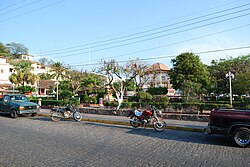Santo Domingo Tehuantepec
|
Tehuantepec Guisi’si Gui |
||
|---|---|---|
| City & Municipality | ||
| Santo Domingo Tehuantepec | ||

View of the main square of the city
|
||
|
||
| Location in Mexico | ||
| Coordinates: 16°19′28″N 95°14′20″W / 16.32444°N 95.23889°WCoordinates: 16°19′28″N 95°14′20″W / 16.32444°N 95.23889°W | ||
| Country |
|
|
| State | Oaxaca | |
| Founded | 15th century | |
| Government | ||
| • Municipal President | José Luis Villalobos | |
| Area | ||
| • Municipality | 965.8 km2 (372.9 sq mi) | |
| Elevation | 55 m (180 ft) | |
| Population (2005) | ||
| • Municipality | 57,163 | |
| • Seat | 39,529 | |
| Time zone | CST (UTC-6) | |
| Postal code (of seat) | 70760 | |
Tehuantepec (Spanish pronunciation: [tewanteˈpek], in full, Santo Domingo Tehuantepec) is a city and municipality in the southeast of the Mexican state of Oaxaca. It is part of the Tehuantepec District in the west of the Istmo Region. The area was important in pre Hispanic period as part of a trade route that connected Central America with what is now the center of Mexico. Later it became a secondary capital of the Zapotec dominion, before it was conquered by the Spanish in the early 16th century.
The city is still the center of Zapotec culture in the Isthmus of Tehuantepec and is the second largest in the region. The city is known for its women and their traditional dress, which was adopted by Frida Kahlo. Tehuantepec has a reputation for being a “matriarchal society.” Women do dominate the local markets and are known to taunt men. However, political power is still the domain of men. The city experienced a short economic boom in the early 20th century related to a rail line that was built linking the two oceans, but it was soon eclipsed by the Panama Canal. There have been plans to resurrect the line linking the Gulf of Mexico and Pacific Ocean but financing has been a problem.
Tehuantepec is the second largest city on the Isthmus of Tehuantepec in the south of Mexico. Founded by the Zapotecs in the period just before the arrival of the Spanish in the 16th century, Tehuantepec remains the center of Zapotec culture in the Isthmus. One important symbol of this culture is the image of a Zapotec woman from the area called La Tehuana. In the 2000s, a sculpture of this figure was created by Miguel Hernández Urbán from the State of Mexico. The sculpture is found at the main entrance to the city of Tehuantepec, made of local marble and fine wood along with stainless steel brought from Mexico City. The work made Hernández an "adopted son" of the city. The city remains home to many traditions and customs which are centuries old, with many, especially in the market, still favoring the Zapotec language over Spanish. The city reached its height in the early 20th century with the arrival of the railroad. However, since then the importance of this railroad has severely diminished by the building of the Panama Canal. Today the city is considered to be poor, with many of its buildings in disrepair. Many survive on subsistence commerce. Many motorcycle taxi operators in Tehuantepec and other cities in Oaxaca are underage, between 13 and 15. The city also has had problems with stray dogs including an incident when about twenty dogs took over the main entrance.
...
Wikipedia


